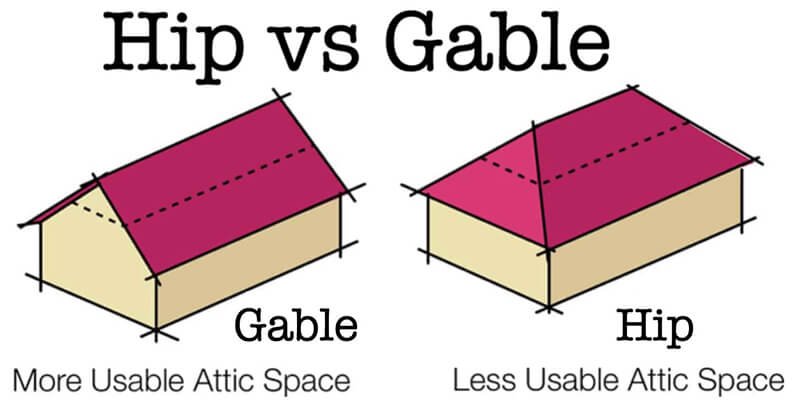Choosing the right roof style for your home is crucial, especially in a climate like San Antonio, TX. When comparing hip roofs vs gable roofs, it’s important to understand the differences, benefits, and drawbacks of each. This article delves into these two popular roofing styles, helping you make an informed decision.
What is a Hip Roof?
Design and Structure
A hip roof is characterized by slopes on all four sides, which meet at a ridge or a single peak. This design is visually appealing and structurally sound, distributing weight evenly across the structure.
Advantages of Hip Roofs
Hip roofs are known for their stability and resistance to wind. The inward slope of all four sides makes them more durable and less susceptible to damage during storms. This design also allows for better rain runoff, reducing the likelihood of water damage.
Disadvantages of Hip Roofs
One downside of hip roofs is their complexity and cost. The design requires more materials and labor, which can increase the overall cost of installation. Additionally, the interior space under a hip roof can be less than that of a gable roof due to the inward slopes.
What is a Gable Roof?
Design and Structure
A gable roof features two sloping sides that meet at a central ridge, creating a triangular shape on each end. This design is straightforward and efficient, making it a popular choice for many homeowners.
Advantages of Gable Roofs
Gable roofs are easier and cheaper to build due to their simple design. They provide excellent ventilation and more attic space, making them ideal for homeowners looking to maximize interior volume. The steep slopes also allow for better water runoff, which is beneficial in wet climates.
Disadvantages of Gable Roofs
While gable roofs are generally sturdy, they are more vulnerable to wind damage compared to hip roofs. The open ends can catch wind like a sail, potentially causing damage in severe weather conditions.
Comparing Hip Roofs and Gable Roofs
Aesthetic Appeal
Both hip and gable roofs offer unique aesthetic advantages. Hip roofs provide a more uniform and symmetrical look, which can enhance the curb appeal of a home. Gable roofs, on the other hand, are more versatile in design and can be adapted to various architectural styles.
Structural Integrity
Hip roofs generally offer better structural integrity due to their design. The inward slopes distribute the load evenly, making the structure more stable and resistant to high winds. Gable roofs, while still robust, may require additional bracing in areas prone to strong winds.
Cost Considerations
The cost of a roof depends on various factors, including materials and labor. Hip roofs typically cost more due to their complex design and the additional materials required. Gable roofs are generally more affordable and quicker to build, which can be a significant consideration for budget-conscious homeowners.
Weather Resistance
In terms of weather resistance, hip roofs have the upper hand. Their design makes them more resilient to wind and heavy rain. Gable roofs, while efficient in rain runoff, are more susceptible to wind damage due to their open ends.
Interior Space and Attic
Gable roofs provide more attic space due to their steep slopes, making them ideal for homeowners who need extra storage or living space. Hip roofs, with their inward slopes, offer less usable attic space, which can be a drawback for some homeowners.
Best Applications for Hip Roofs
Hip roofs are best suited for areas prone to high winds and heavy rains. Their design offers excellent stability and durability, making them a smart choice for homeowners in hurricane-prone regions.
Best Applications for Gable Roofs
Gable roofs are ideal for homes in areas with moderate weather conditions. They provide ample attic space and are easier and cheaper to build, making them a popular choice for many homeowners.
Maintenance Considerations
Hip Roof Maintenance
Maintaining a hip roof can be more challenging due to its complexity. Regular inspections are necessary to check for any potential issues with the slopes and joints. Ensuring proper ventilation is also crucial to prevent moisture buildup and extend the roof’s lifespan.
Gable Roof Maintenance
Gable roofs are easier to maintain due to their simpler design. Regular inspections should focus on the ridge and gable ends, where wind damage is most likely to occur. Ensuring that the gutters are clear and functioning properly is also important to prevent water damage.
Cost Analysis
Initial Installation Costs
The initial cost of installing a hip roof is typically higher than a gable roof. This is due to the additional materials and labor required for the complex design of a hip roof. Gable roofs, with their straightforward design, are generally more affordable to install.
Long-term Costs
Long-term costs include maintenance and potential repairs. While hip roofs may require more maintenance due to their complexity, their durability can result in fewer repairs over time. Gable roofs, while easier to maintain, may require more frequent repairs in areas prone to high winds.
Energy Efficiency
Energy efficiency is an important consideration when choosing a roof style. Hip roofs, with their inward slopes, can provide better insulation, potentially reducing heating and cooling costs. Gable roofs, with their steeper slopes, offer better ventilation, which can also contribute to energy savings.
Popularity in San Antonio, TX
In San Antonio, TX, both hip and gable roofs are popular choices due to the city’s diverse architectural styles and weather conditions. Homeowners often choose hip roofs for their durability and resistance to wind, while gable roofs are favored for their cost-effectiveness and additional attic space.
Conclusion: Which Roof is Right for You?
Choosing between a hip roof and a gable roof depends on various factors, including budget, weather conditions, and personal preferences. Hip roofs offer superior stability and weather resistance, making them ideal for areas prone to severe weather. Gable roofs, with their simplicity and affordability, are a great choice for those looking to maximize interior space and reduce costs.
FAQs
What are the main differences between hip roofs and gable roofs?
Hip roofs have slopes on all four sides, while gable roofs have two sloping sides that meet at a ridge. This structural difference affects their stability, cost, and interior space.
Which type of roof is more cost-effective?
Gable roofs are generally more cost-effective due to their simpler design and lower material and labor costs. However, long-term costs should also be considered, as maintenance and repairs can vary.
Are hip roofs or gable roofs better for hurricane-prone areas?
Hip roofs are better suited for hurricane-prone areas due to their inward slopes and superior wind resistance. Their design helps them withstand strong winds more effectively than gable roofs.
Can a hip roof have gables?
Yes, a hip roof can have gables. This hybrid design combines the stability of a hip roof with the aesthetic and practical benefits of gables, providing a unique and versatile roofing San Antonio option.
What is the best roof type for maximizing interior space?
Gable roofs are best for maximizing interior space. Their steep slopes provide more attic space, which can be used for storage or additional living areas.
Which roof type is easier to maintain?
Gable roofs are easier to maintain due to their simpler design. Regular inspections and maintenance are straightforward, focusing mainly on the ridge and gable ends. Contact Superior roofing San Antonio for regular inspections and maintenance of your roof
Do hip roofs or gable roofs last longer?
The lifespan of a roof depends on various factors, including materials and maintenance. Generally, hip roofs can last longer due to their stability and resistance to wind and water damage, but proper maintenance is essential for both types.


